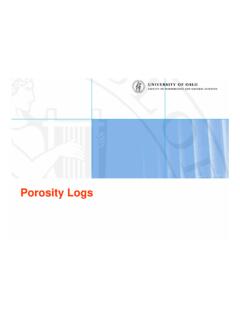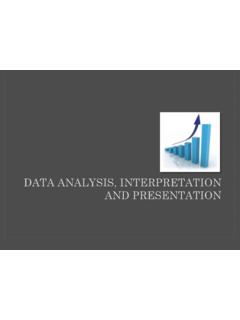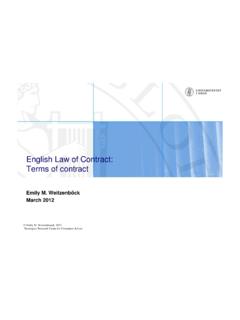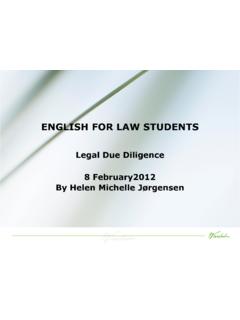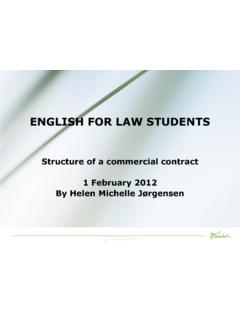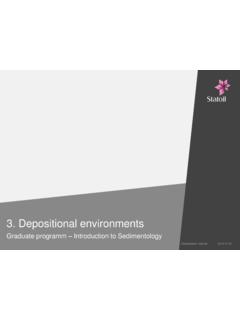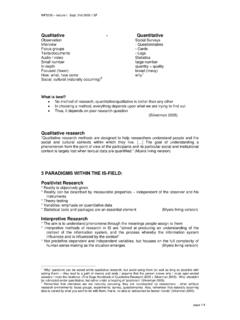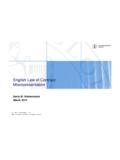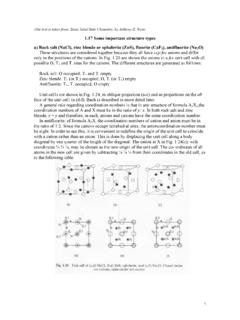Transcription of solutions chapter 9 - Universitetet i Oslo
1 200 chapter 9 Exercise solutions chapter 9, Exercise solutions , Principles of Econometrics, 3e 201 EXERCISE From the equation for the AR(1) error model 1ttteev = +, we have ()( )()()211varvarvar2 cov,ttt tteev ev = ++ from which we get 22220eev = + + ()2221ev = and hence 2221ve = To find ()1ttEee we note that 2111ttttteeee v = + Taking expectations, ()()22110ttteEeeEe = + = Similarly, 2122ttt ttteee ee v = + and ()( )()2221210ttt ttteEeeEe eEee = + = = chapter 9, Exercise solutions , Principles of Econometrics, 3e 202 EXERCISE (a) Using hand calculations 121212 TtttTtteere = ==== , 232223 TtttTtteere = ==== (b) (i) The test statistic for testing 01:0H = against the alternative 11:0H is 110 =.
2 Comparing this value to the critical Z values for a two tail test with a 5% level of significance, ( ) and ( ) , we do not reject the null hypothesis and conclude that 1r is not significantly different from zero. (ii) The test statistic for testing 02:0H = against the alternative 12:0H is 210 =. Comparing this value to the critical Z values for a two tail test with a 5% level of significance, ( ) and ( ) , we do not reject the null hypothesis and conclude that2r is not significantly different from zero. chapter 9, Exercise solutions , Principles of Econometrics, 3e 203 EXERCISE (a) Equation ( ) can be used to conduct two Lagrange multiplier tests for AR(1) errors.
3 The first test is to test whether the coefficient for 1 te is significantly different from zero. The null hypothesis is 0 = The value of the test statistic is The critical t value for a 5% level of significance and 23 degrees of freedom is Since > , we reject the null hypothesis and conclude that first order autocorrelation is present. The second LM test examines whether or not the 2R from ( ) is significant. The null hypothesis is again 0:0H = and the test statistic value is 226 R= = = When the null hypothesis is true, LM has a 2(1) -distribution with a 5% critical value of Since > , we reject the null hypothesis and conclude that first order autoregressive errors exist.
4 (b) Ignoring autocorrelation means the estimates will be unbiased but no longer the best estimates. Furthermore, the standard errors will be incorrect resulting in misleading confidence intervals and hypothesis tests . The standard errors from the model with AR(1) errors are larger than the standard errors from the least-squares estimated model. Thus, it is likely that the least squares estimates and standard errors have overstated the precision of the estimates in the relationship between disposer shipments and durable goods expenditure. If autocorrelation is ignored, the confidence intervals will be narrower than the correct confidence intervals, and hypothesis tests will have a probability of a type 1 error that is greater than the specified significance level.
5 chapter 9, Exercise solutions , Principles of Econometrics, 3e 204 EXERCISE (a) Under the assumptions of the AR(1) model, corr( ,)kttkee = . Thus, (i) 1corr( ,) = = (ii) 444corr( ,) = = = (iii) = == (b) (i) 1corr( ,) = = (ii) 444corr( ,) = = = (iii) = == When the correlation between the current and previous period error is weaker, the correlations between the current error and the errors at more distant lags die out relatively quickly, as is illustrated by a comparison of = in part (a)(ii) with = in part (b)(ii).
6 Also, the larger the correlation , the greater the variance 2e , as is illustrated by a comparison of = in part (a)(iii) with = in part (b)(iii). chapter 9, Exercise solutions , Principles of Econometrics, 3e 205 EXERCISE (a) (i) 1 TTee+= (ii) 221 TT Tee e++= = (b) Equation ( ) gives us the nonlinear least squares estimates of the coefficients 1 = and 2 =. The final observation in is ,A= Therefore, the nonlinear least squares residual for the last observation is ()()34ln ln = (c) Forecasts for 1Te+ and 2Te+ are given by 1 += = = 21 ++= = = (d) Noting that 1 ,TTee+= the forecast value for 1ln()TA+can be calculated as n1121 ln()ln(), ln(1) ++= + + =+ += Similarly, the forecast value for 2ln()TA+is n21222 ln()ln() ln( )
7 +++= + +=++= chapter 9, Exercise solutions , Principles of Econometrics, 3e 206 Exercise (continued) (e) In chapter 4 we are told that there are two ways to forecast a dependent variable when the left-hand side of the equation is in the form of the logarithm of that variable. The first method is to calculate the natural predictor ny, which is the better predictor to use when the sample size is small 12 exp()nybbx=+ The second method is to calculate a corrected predictor cy, which is the better predictor to use when the sample size is large 2 /2212 exp(/ 2)cnybbxye =++ = Applied to our nonlinear least squares estimation, the natural predictors are ()()11211 expln()exp ln(1) +++= + +=++= ()()21222 expln()exp ln( ) +++= + +=+ += The corrected predictors are ()()2112112 expln()2exp ln(1)
8 +++= + ++ =+++= ()()2212222 expln()2exp ln( ) +++= + ++ =+ ++= chapter 9, Exercise solutions , Principles of Econometrics, 3e 207 EXERCISE We consider two ways to derive the lag weights, by recursive substitution and by equating coefficients of the lag operator. Recursive substitution is tedious but does not require new machinery. Using the lag operator requires new machinery, but is less tedious. Recursive substitution One way to find the required expressions for the lag weights is to use recursive substitution on the ARDL model.
9 Once we have substituted in enough lagged equations, we can determine the lag weights by observation. Recursive substitution begins with the current ARDL model 33 11 2 2 3 3ttttttyxyy yv = + + + + + (1) We lag the equation by 1 period 1341223341ttttttyxy yyv = + + + + + (2) and then substitute it back into (1) ()33 134 1 2 2 3 3 4122 33233 1134 1 2 12 3 13 4112 23 3 ttttttttttttttttt ttyxxyyyvyyvxxyyyvy yv = + + + + + + ++ + += + + + + + + + + + + (3)
10 This process is repeated with the larger lags until the required tsx is reached. In this model, we stop the process of recursive substitution after substituting in At this stage it should be clear that further substitution would not involve any additional lags of the independent variables tsx for 1, 2 , 3, 4, 5 o r 6s=. This ensures that the expressions for the lag weights that we determine will not change with further substation. Rearranging the final equation should give an expression similar to 2311 1 12 212 32333 134 135 235 13642123 6123 633 6141 24222124124134 241343312 513 6ttt t t tttttttttttttyxx x x xxxxyyyyyyyyy = + + + + + + + + + + + + + + + + + + + + + + + + + 32213 13 5 12 52125 235 235 235 1236223611 12 22 123 123 33tttttttttt ttttttvyyyyyy yyvv v vvv v + + + + + + + + + + + + + + + (4)
